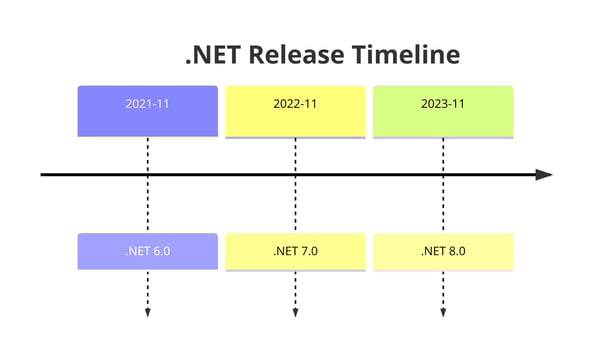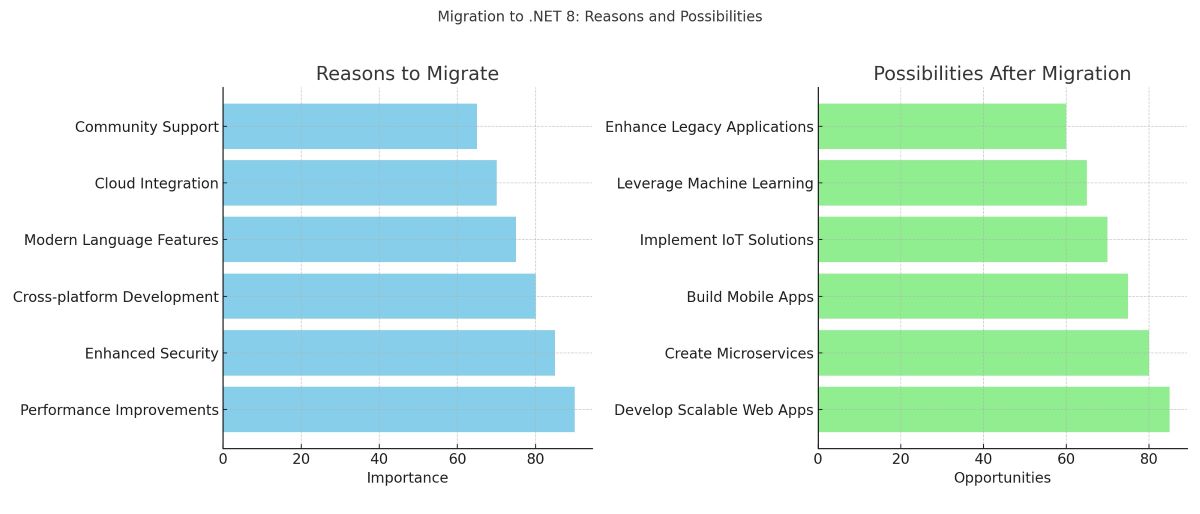How does .NET 8 change the face of cross-platform development? What role does it play in enabling .NET to take over more than 25% of the development sector?
Microsoft .NET Framework unveiled .NET 8 in November, keeping up with its habit of yearly updates and introducing noteworthy improvements along with fresh additions to its already strong framework. The newest edition that a DOT NET development company uses highlights Microsoft's pledge towards creativity and assistance for the developer community.
Particular relevance comes into play at .NET Core cross-platform development, with new features in the .NET 8 version that will further simplify development processes while increasing performance and security across varying platforms. This is also because, per Statista, the .NET frameworks and libraries are the most used by developers. All the .NET techs also dominate over 25% of the development sector.
In November 2021, .NET 6.0 was released by Microsoft, then in November 2022, .NET 7.0, and in November 2023, .NET 8.0 followed up. Want to hire .NET developers? Modernize your project through the most recent .NET technologies!

Cross-Platform Development
Cross-platform development enables programmers to write their code at one time and then deploy it on several platforms, such as Windows, Linux, and macOS. Thus, the approach has become extremely popular because of its efficiency and cost savings that it offers. Therefore, with an advanced feature set playing a critical role in .NET cross-platform development support for building versatile, high-performing applications.
Features of .NET 8 for Cross-platform Development
#1. Garbage Collector Improvements
The largest enhancement made to .NET 8 is the Garbage Collector (GC). This now enables dynamic adjustment of an application's memory limit by the GC. This becomes very handy in optimally native cloud applications that execute on platforms such as Kubernetes. The application will allocate memory dynamically through this new feature, thereby ensuring high performance as well as low resource consumption in different environments.
#2. JSON Enhancements
Added among the major enhancements are improvements to JSON serialization and deserialization, greater support for new numeric types such as half struct, among others. This will be very important to applications making use of hardware accelerators and Neural Processing Units (NPUs) since it is aligned with floating-point hardware and thus enhancing performance. In addition, the improvements ensure that .NET applications can easily exchange data on various platforms, thus creating a connected development ecosystem. Go ahead and unravel the true potential that comes with web app development when using ASP.NET Core. Get right inside some of the leading reasons why ASP.NET stands as the best framework – join us now!
#3. Randomness Tools
A new code tool for providing randomness can be seen as a blessing to developers, particularly those working with machine-learning applications. In the new feature, randomness may be used directly as a selector, thus increasing potency and strength support on different platforms of machine-learning apps.
#4. Cryptography Enhancements
Cyber threats are becoming more sophisticated; hence, the upgrade of .NET 8 with SHA-3 support is a timely upgrade towards fortified security in .NET applications. This new feature serves as another alternative to the most current widely used SHA-2 by ensuring that applications are kept secure from an evolving threat landscape. The update cross-platform development, particularly where different ranges of security challenges are common to find applications.
#5. Silicon-Specific Features
It introduces features that are based on the Intel AVX-512 instruction set, meaning a big jump in performance for applications that rely heavily on data processing. These features of modern hardware ensure optimal performance of .NET applications across different platforms, making the best use of all the underlying hardware capabilities.
#6. Time Abstraction
The new time abstraction features come to help against elusive and difficult-to-manage time-related bugs by allowing local time providers across different and varied time zones. Simplification of handling times within cross-platform applications is definitely an improvement for custom developers working with global applications, where proper management of times across various time zones is more than just important.
5 Most Popular Use Cases of .NET 8 in Cross-Platform Development
A new version of Microsoft’s .NET platform, known as .NET 8, has come up with several features and enhancements that eventually lead to making it an attractive option for different scenarios of cross-platform development. Here are the five most common situations in which it would be used by a custom .NET development company, where .NET 8 excels – specifically within cross-platform environments:
#1. Microservices Architecture with Docker
Use Case Description: Robust, scalable, and flexible solutions facilitated by .NET 8 through microservices architectures that can be easily containerized via Docker. In this setup, applications are built as a set of small, individual yet loosely coupled services, in the most general sense of the term. Individual development and deployment for each microservice make attaining agility and efficiency possible.
Benefits: It delivers enhanced scalability and agility coupled with simplified sustainment and accelerated go-live cycles. Running hand-in-hand with Docker, this means simple container orchestration that leads to smooth deployments across every environment you might use and all platforms.
|
Confused about choosing between .NET Core and .NET Framework for your app development? Dive into our comprehensive comparison to make an informed decision today! |
#2. AI and Machine Learning with ML.NET
Use Case Description: The .NET 8-based AI application use case alongside ML.NET describes how the new release of ML.NET supports building, training, and deploying machine learning models for applications that can range from predictive analytics to image classification within the same well-known .NET ecosystem. Indeed, ML.NET is an open-source cross-platform machine-learning framework supported by .NET 8 that targets AI and machine-learning applications.
Benefits: Helps put machine learning into .NET applications without having to learn another programming language or framework for it. Thus, intelligent applications can be developed with ease on any platform.
#3. Cross-Platform Mobile Development with MAUI
Use Case Description: .NET Multi-platform App UI is a single codebase native mobile and desktop application for Android, iOS, macOS, and Windows presented by .NET 8. It serves as an excellent means for cross-platform mobile app development. Find out why .NET MAUI should be your number one bet in app development undertakings. Be informed to innovate with us!
Benefits: Increases code sharing and reduces development and maintenance costs. It also leverages native device capabilities so that high performance and native user experience are achieved on all platforms.
#4. IoT Applications
Use Case Description: .NET 8 greatly facilitates the building of Internet of Things (IoT) applicati.nerframeons.With its cross-platform support, developers can build software for a wide range of IoT devices, whether they are based on Windows IoT, Linux, or otherwise. The framework allows for the development of both the device side and the cloud side of software, offering full IoT solution enablement.
Benefits: Helps ease the development of custom IoT applications with support for a wide range of devices. Enables easy integration with cloud services to process and analyze data, thereby improving the functionalities of IoT solutions.
#5. Desktop Applications with Cross-Platform Support:
Use Case Description: .NET 8 provides further support for the creation of strong desktop applications through cross-platform solutions like Avalonia and Uno Platform. Applications to be created with these frameworks can run on Windows, Linux, and macOS from a single codebase, exploiting the power and flexibility of the .NET ecosystem.
Benefits: Enables the creation of aesthetic, high-performance desktop applications whose reach can be extended by executing them on more than one operating system. It lowers the complexity and cost associated with developing and maintaining individual custom applications for every platform.
Migrating to .NET 8
Migration to .NET 8 has to be preceded by a thorough review of the current applications for any compatibility issues and updating them to target .NET 8. It is very easy with the help of the .NET Upgrade Assistant, which allows automation of most steps that need to be taken during migration so that you do not skip any part. Also, ensure to run your application thoroughly after migration since there could be issues resulting from the numerous new features and enhancements introduced in .NET 8.

The graph shows the reasons for migrating to .NET 8 and the fruits that such migration can bear in software development, together with use cases. On the left side, we have reasons that include performance upgrades, security, cross-platform development support, new language features, cloud integrations, and community support.
On the right side of possibilities after migrating to .NET 8 are scalable web applications, microservices, mobile apps, IoT solutions, machine learning opportunities, and improved legacy applications. Every factor is rated by its importance or opportunity it offers, visually describing why and how moving to .NET 8 can be a great deal for a software development project.
A Table Of Comparison: .NET 8 Vs. Other Frameworks
Comparison of .NET 8 with other cross-platform development frameworks shall extend over dimensions like performance, language support, ecosystem, tooling, and community support. The description under comparative analysis includes details about .NET 8 and the top cross-platform development frameworks as of April 2023. However, it should be noted that changes are possible since then because technological evolution is fast.
|
Feature |
.NET 8 |
Flutter |
React Native |
Xamarin |
|
Supported Platforms |
Windows, Linux, macOS, Android, iOS |
Android, iOS, Web, Windows, Linux, macOS |
Android, iOS, Web, Windows (via extensions), macOS (via extensions) |
Android, iOS, Windows, macOS |
|
Primary Programming Language |
C#, F# |
Dart |
JavaScript, TypeScript |
C# |
|
Performance |
High, with native performance on all platforms due to ahead-of-time (AOT) compilation for mobile and just-in-time (JIT) for web and desktop |
High, with AOT compilation and a highly optimized rendering engine |
Good, with performance slightly hindered by the JavaScript bridge |
Good, with direct access to native APIs but slightly hindered by the mono runtime layer |
|
Ecosystem |
Extensive, with a large library of NuGet packages for various needs |
A rich ecosystem with a growing set of Flutter-specific packages |
Massive benefits from the extensive NPM package ecosystem |
Large, supported by all .NET libraries plus Xamarin-specific packages |
|
Tooling |
Visual Studio, Visual Studio Code, JetBrains Rider, and others |
Flutter SDK with command-line tools and Dart DevTools for debugging and profiling |
React Native CLI and Chrome DevTools for debugging |
Visual Studio with Xamarin tools integrated, Visual Studio for Mac |
|
UI Development |
Flexible, with support for both native and custom UI development across platforms |
Widget-based, highly customizable, and expressive UI components |
Component-based, with a rich set of community-developed UI libraries |
Uses native UI controls, allowing for a native look and feel on each platform |
|
Learning Curve |
Moderate, especially for those familiar with C# and the .NET ecosystem |
Moderate Dart is easy for JavaScript or Java developers, but understanding the widget and state management concepts can take time |
Moderate, requires knowledge of JavaScript and the React framework |
Moderate to high, requires knowledge of C# and .NET, plus an understanding of mobile development concepts |
|
Community Support |
Large, with extensive documentation, tutorials, and community forums |
Proliferating, with a supportive community and a wealth of resources |
Very large and supported by a vast community and Facebook |
Significant, especially since it's part of the broader .NET community |
This table should serve as the beginning of an assessment regarding which framework would be most applicable to your cross-platform development needs. The unique requirements of each project-those pertaining to the target audience, performance needs, and expertise of the development team-will weigh heavily against the choice of a framework.
What Would Be The Difference Between .NET 8 vs .NET 9?
Let’s try to see what's the difference between .NET 8 vs .NET 9 from a rather simplified angle of approach:
.NET 8: The base for performance apps that are cloud-native. It brought better memory management, enhanced security protocols, and more unified developer tools.
.NET 9: Taking .NET 8 upgrades a step beyond AI features now; even still, it consolidated software for mobile and cloud applications by updating tools that stream cross-platform app development. .NET 9 is also essentially an enriched edition that stretches further the capabilities of .NET 8 to embody more smart features and artificial intelligence conformance.
Conclusion
The .NET 8 release represents a major turn in the evolutionary curve for .NET development, with new features and enhancements filling support for cross-platform development with an upgrade to .NET 9. Major garbage collector improvements through cryptography enhancements empower developers to create fast, secure, and high-performing applications over different platforms.
As developers of DOT NET development services keep moving toward cross-platform development, facilitating this approach by using .NET 8 will ensure keeping its evident place at the center of attention with further advancements toward tackling the ever-so-connected digital world, and challenges that come their way.
Author










